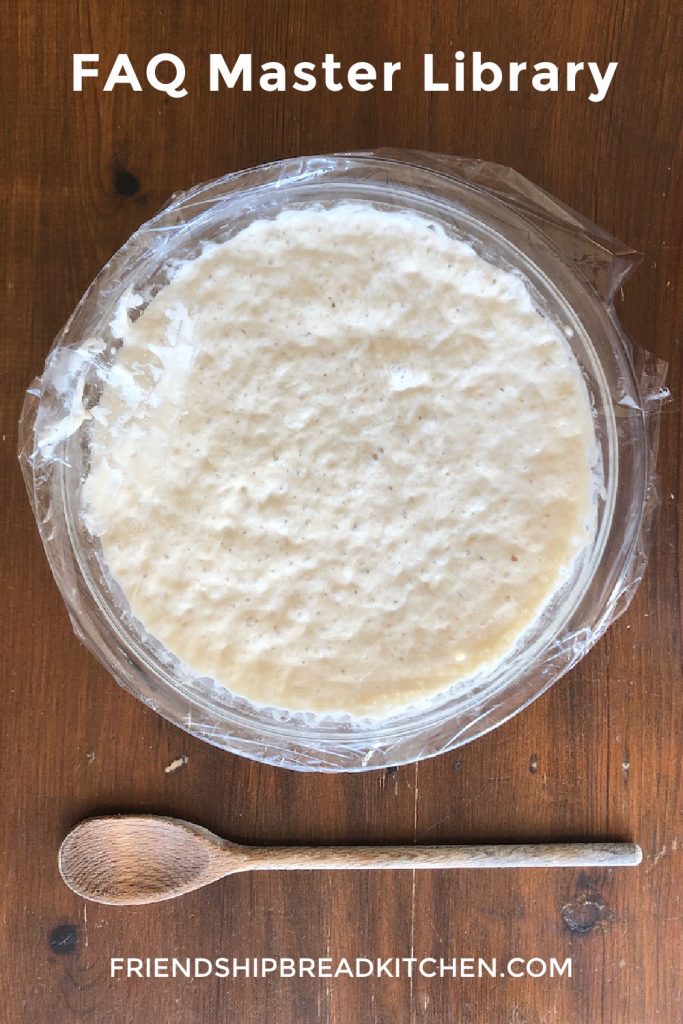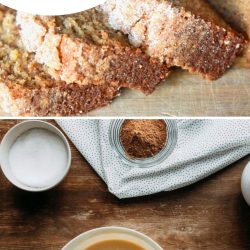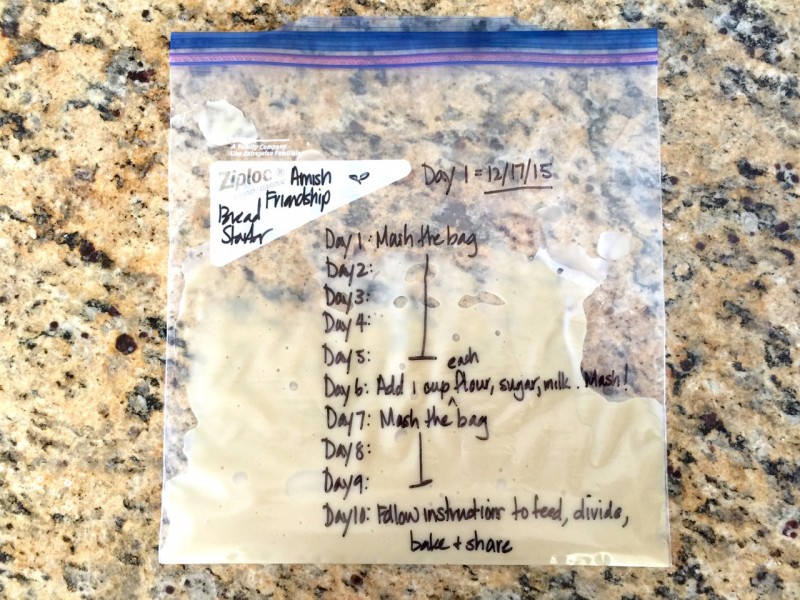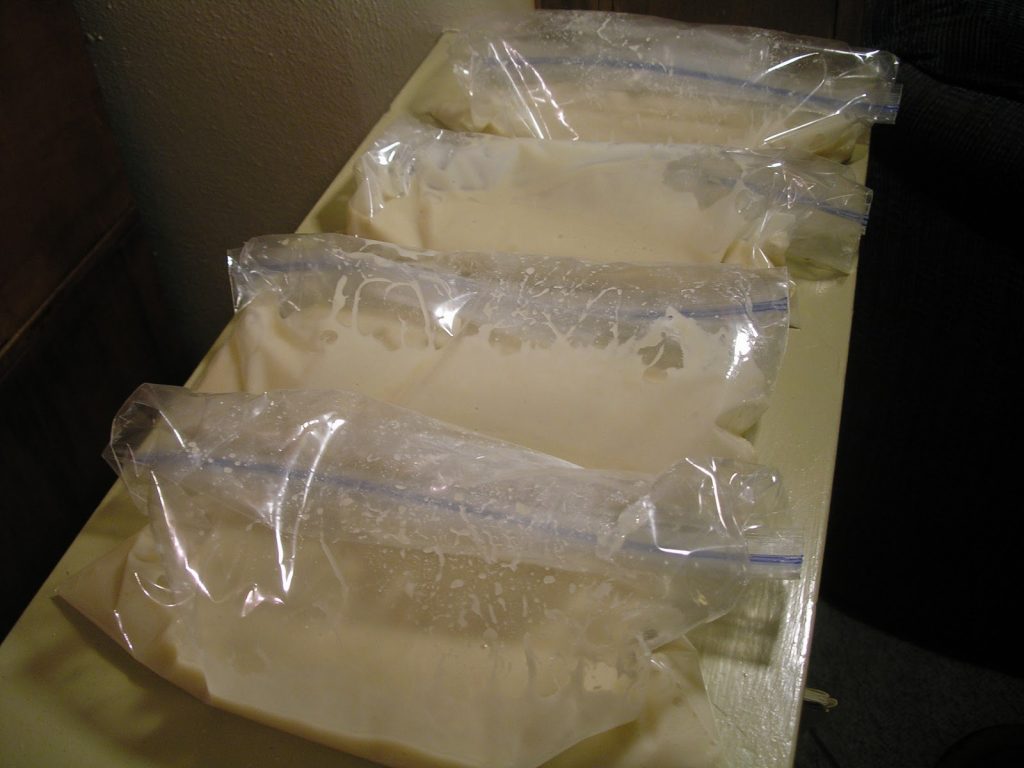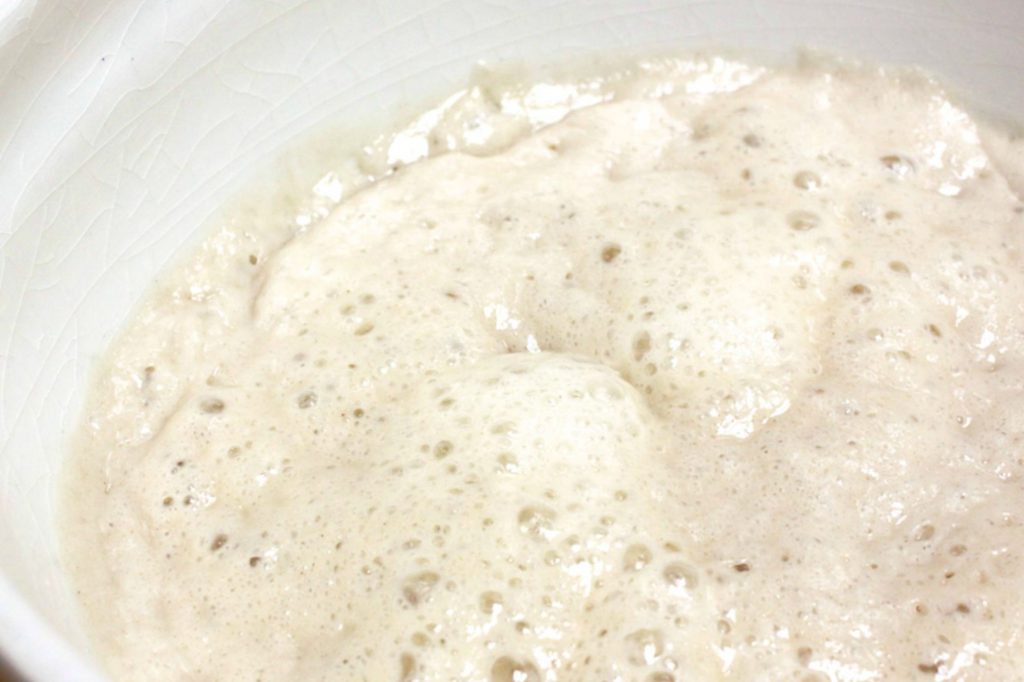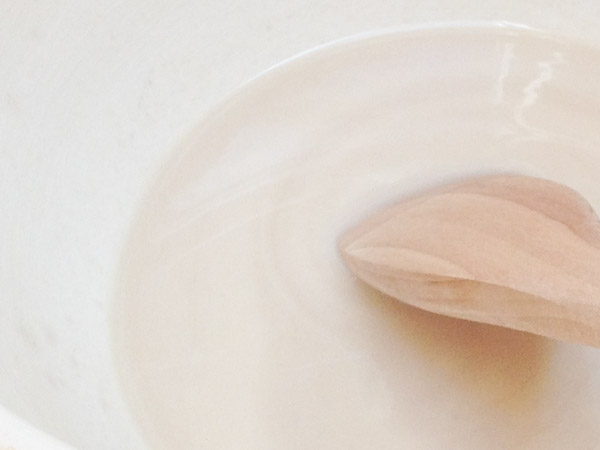Have a question? I’ve got answers! At least about Amish Friendship Bread. This is the master FAQ library of every question I get asked, over and over again, but don’t forget that there are tutorials, individual deep-dive FAQs, and simple but clever hacks to also help you out.
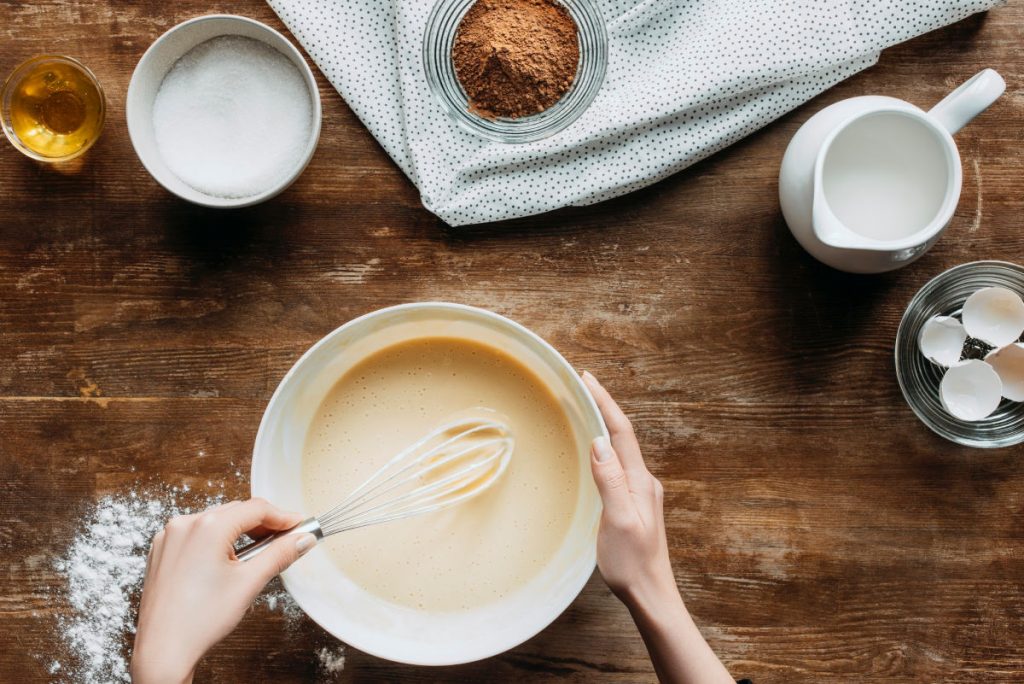
Frequently Asked Questions
The following are the most frequently asked questions I receive about Amish Friendship Bread. If you can’t find what you’re looking for, head over to our Facebook page and post your question on our wall.
- The instructions I received with my bread and starter are so confusing. Help!
- What type of yeast should I buy?
- I’ve made my starter but it’s been 10 minutes and nothing’s happened. What should I do?
- Can I make the starter using whole-wheat flour?
- Is there a starter recipe that is gluten-free?
- I’m lactose intolerant. Can I use lactose-free or rice milk?
- I do not like using commercial yeast. How can I make the starter without the yeast?
- Can I use an existing sourdough starter to make an Amish Friendship Bread Starter?
- How is an Amish Friendship Bread starter different from a regular sourdough starter?
- How long will this starter go on?
- How do I make the starter? Does anyone have one they can send me?
- What is the nutritional value of the bread after baking?
- I’m afraid my bag of starter is going to explode! Could that happen?
- Can I keep my starter in the refrigerator?
- How often should I feed my starter?
- Will a cold kitchen affect my starter?
- I was supposed to bake the other day and forgot — is my starter spoiled and should I start over to be safe?
- I just fed my starter and now it doesn’t look like it’s doing anything at all. What happened?
- Why isn’t my starter isn’t bubbling with the artificial sweetener?
- Can you use the starter in a recipe on the first day of making the starter?
- I’m tired of this starter controlling my life! How do I get rid of it?
- I don’t have anyone to pass my starter on to. How do I maintain it so that I can use it when I need it?
- How do I store my starter?
- Should I store my starter in a bag, bowl, or jar?
- How should I store my starter safely?
- Can you freeze the bread?
- What should my starter smell like?
- My starter smells like acetone (or paint thinner or nail polish remover). Has it gone bad?
- What should my starter look like?
- I woke up and my starter looked weird, kind of oily and liquidy. What’s going on?
- Can I use metal utensils or bowls with my starter?
- Is it safe to share my starter with someone else?
- When a recipe says “1 cup Amish Friendship Bread starter,” I am confused. Is that what it is in the Ziploc bag on Day 10, or is Day 10’s contents, plus the cup milk, sugar, and flour that you add on Day 10?? Help!
- Can I use my hand or counter-top mixer to help mix up my batter?
- Can I use metal pans to bake my bread?
- Do I have to use pudding in my bread?
- I don’t have any instant pudding on hand but I have Jell-O gelatin. Will that work?
- I need to cut out sugar in my baking. Can I use Stevia or any other sugar substitute?
- Have you ever baked your bread before Day 10?
- I baked the cinnamon rolls according to the directions given. Why did mine turn out dry?
- Do I have to grease and flour the pan?
- Does it matter what type of eggs you use for baking? Can I use egg substitutes?
- Am I supposed to prepare the instant pudding or just add it dry to the ingredients?
- My add-ins (nuts, chips, fruit) keep sinking to the bottom of my batter. Why?
- I’m trying to make the traditional sourdough bread recipes with my starter but my dough isn’t rising. Why?
- I live at a high altitude and the recipes aren’t coming out right. Why?
- Are there other things I can make with the starter other than Amish Friendship Bread?
- I’d like to print your recipe and pictures on my blog/website/Facebook page. Do I need permission?
We also have tutorials and a few hacks to help you out, along with our popular expanded FAQ posts to help you get the answer you need.
GETTING STARTED WITH AMISH FRIENDSHIP BREAD
Q. The instructions I received with my bread and starter are so confusing. Help!
A. Basically there are two parts: the care and feeding of your starter, and then the actual baking. Days 1 through 10 are about caring for your starter. On Day 10 you add the final flour, milk, and sugar before dividing into equal portions of 1 cup each (the original instructions that are floating around say 4 portions of 1 cup each, but because many people make their starter from scratch, they tend to end up with more as brand new starters are always more “enthusiastic” than ones that have been around the block). Visit our Amish Friendship Bread Primer here for more information.
The recipe for the actual baking of the bread is the list of ingredients that begins with 1 cup of starter and ends with you sliding two loaf pans into the oven. So if someone gave you a bag of starter, which should be about 1 cup, the day they gave it to you is Day 1. You go through the ten days and then on Day 10 you bake.
Q. What type of yeast should I buy?
A. We recommend active dry yeast which comes in ¼-ounce packets or in jars, but you can also use rapid rise yeast or fresh/compressed yeast.
Q. I’ve made my starter but it’s been 10 minutes and nothing’s happened. What should I do?
A. First, check the expiration date on your yeast. The starter is also slower to activate in cooler kitchens, so make sure you have it in a place that’s warm and draft-free. If you’re convinced your yeast is still good, then cover the bowl with plastic wrap and give it a little more time. If by the next day nothing has happened, toss out your starter and buy some new yeast.
Q. Can I make the starter using whole-wheat flour?
A. Yes! Along with whole wheat, rye is another popular flour that seems to do well in starters. However, it’s not always as easy to replace with a 1:1 substitution, so check out my tutorial for baking Amish Friendship Bread with whole wheat flour.
Q. Is there a starter recipe that is gluten-free?
A. We’re still working on perfecting the ideal GF starter, but people have reported limited (but short-term) success with different nut flours and blends. One option is to begin with a Potato Flake starter and test blending different gluten-free flour and starch options for baking.
Q. I’m lactose intolerant. Can I use lactose-free or rice milk?
A. Yes. Many sourdough starters rely on just flour and water, so milk gives it an extra boost of (sometimes but not always) lactobacilli/probiotics and sugars, not to mention a little flavor. Rice, soy, and other non-dairy milks work as well–experiment until you determine what works best for you.
In baking, it’s certainly not a problem but keep an eye on your starter and make sure it stays fresh and doesn’t spoil. You can also use water, which is what traditional sourdough starters use. Since most of the recipes are made with the flavor profile of an Amish Friendship Bread starter in mind, your end result may vary a little.
Q. I do not like using commercial yeast. How can I make the starter without the yeast?
A. You can omit the yeast in the starter and rely on the wild airborne yeast in the air to metabolize your starter. Results do vary with this method but there are lots of great discussion groups about this at The Fresh Loaf, one of our favorite bread sites. There is also a great post about this at the Wild Yeast Blog.
Q. Can I use an existing sourdough starter to make an Amish Friendship Bread starter?
A. Yes! Any sourdough starter can feed another sourdough starter strain. I show you how to use a regular sourdough starter for baking this bread here.
Q. How is an Amish Friendship Bread starter different from a regular sourdough starter?
A. It’s simple! In a nutshell, a sourdough starter is made of flour and water, and an Amish Friendship Bread starter is made is flour, sugar, and milk. An Amish Friendship Bread starter also uses commercial yeast to kick it off (unless you received your starter from a friend), whereas a traditional sourdough starter does not. (To read more about the differences in hydration levels and the sweetness factor, read here)
Q. How long will this starter go on?
A. Indefinitely unless it gets contaminated, gets too cold (so goes dormant), or isn’t properly fed. As long as you keep your starter healthy, you’ll never run out! Once you get a healthy starter going, consider putting some aside in the freezer (1 cup in a Ziploc bag) as a backup.
Q. How do I make the starter? Does anyone have one they can send me?
A. If you don’t have anyone to give you a starter, you can make your own starter easily!
Also – please exercise caution and good judgment when accepting a starter from someone you don’t know–usually, a good sniff will tell you if the starter is any good (and if there is anything bad in there, it will probably contaminate the starter anyway), but better to err on the side of caution and make your own or ask someone you know to share theirs.
CARING FOR YOUR STARTER
Q. I’m afraid my bag of starter is going to explode! Could that happen?
A. Yep, it sure can! If your bag starts to puff up, just open up the bag and let out the extra air. If you keep your starter in a container and it looks like it’s about to spill over, just give it a good stir. You’ll see more activity on warmer days, too.
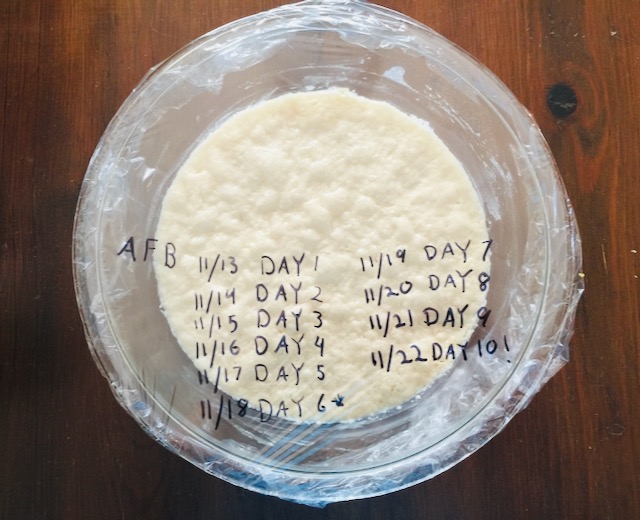
Q. Can I keep my starter in the refrigerator?
A. You can, but it will slow down the fermenting process and lengthen the feeding cycle, so I generally don’t recommend it until your starter is well-established. Once you know you have a solid starter on your hands, place it in the fridge (dated!) in a container that allows it to breathe, and feed it weekly at the proper proportions (each cup of starter = 1 cup flour, 1 cup sugar, 1 cup milk), which means you’ll need to discard or use some of the starter regularly. Learn how to refrigerate your starter here.
Let your starter come to room temperature before using in a recipe. If you want to take a break and store your starter for future use, check out this post on freezing your starter.
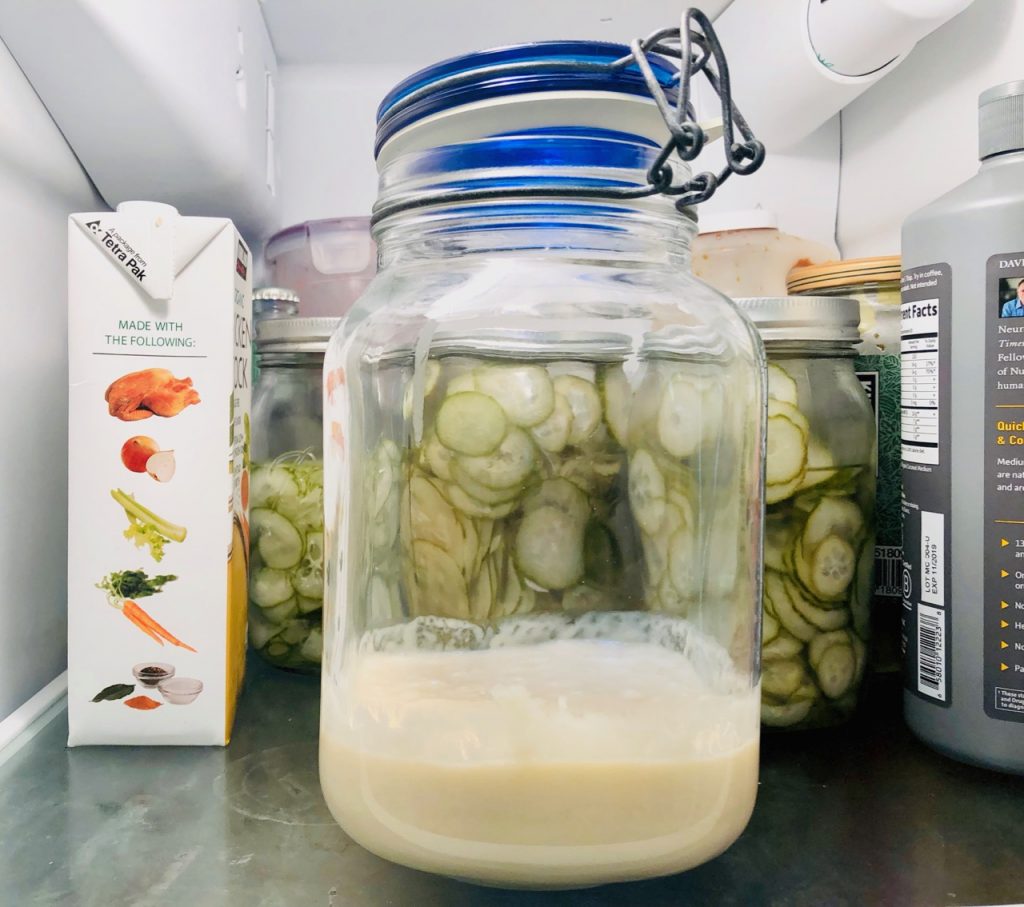
Q. Will a cold kitchen affect my starter?
A. Yes. If you find that your kitchen is cold or drafty, store your starter in an unheated oven or microwave, or move it to a sunny spot. Plastic containers are warmer than porcelain or glass. A cold kitchen won’t hurt your starter if it’s cool or cold, but it will make the starter less active or even go dormant (that’s what happens when you put starter in the fridge or freezer). Just warm it up and it’ll be fine.
Q. I was supposed to bake the other day and forgot — is my starter spoiled and should I start over to be safe?
A. If you have a healthy starter (bubbles, yeasty), then you also have a hardy starter. Most starters live on indefinitely as long as they are fed regularly (and with the right proportions–see this post on maintaining a healthy starter). If it’s been between 1-3 days late for a feeding, just give it a good feeding, divide, and bake.
If you notice a foul smell, discoloration, or mold, toss it immediately and start over (this is also when it’s helpful to have a couple of starters in the freezer – you’ll never run out if/when you make a mistake).
Q. I just fed my starter and now it doesn’t look like it’s doing anything at all. What happened?
A. Starters are sometimes “quiet” after a feeding. Keep it in a warm, draft-free area in your kitchen and cover it with plastic wrap (if in a bowl). In a few hours and certainly by the next day it should be back to its normal self, possibly bubbling over with happiness.
Q. Why isn’t my starter isn’t bubbling with the artificial sweetener?
A. The yeast in your starter needs sugar. Sugar is a carbohydrate and that is what yeast needs to metabolize and grow. Artificial sweeteners are amino acids and won’t help your starter rise and ferment.
During the baking process, it’s easy to find heart-healthy substitutions but it’s a bit trickier with the starter. Some people have said they’ve used sugar alternatives in their starter and it’s worked fine (remembering, too, that the flour converts to sugar as does the milk, so there are still sugars in your starter), but you’ll need to experiment.
We’ll be doing some diabetic recipe testing in the Kitchen so we’ll keep you posted with any new recipes and diabetic-friendly variations!
Q. Can you use the starter in a recipe on the first day of making the starter?
A. The reason the recipe asks you to wait for 10 days is so the starter (comprised of flour, milk, sugar, yeast) has a chance to get robust and ferment. Developing a healthy Amish Friendship Bread starter takes time, but once you have a starter established (after at least one 10-day round), you can bake anytime. You may also find that the longer you keep the starter going, the better it gets!
If you received your starter from someone else, technically you can feed and use the starter at any time (just remember to leave 1 cup in the bowl or bag at all times). But there’s another part, too: there’s something magical about YOU caring for your starter for 10 days. It may sound strange, but I have seen the same starter act differently in different kitchens (and have their good days and bad days in both!). In the end, after 10 days or more, maybe it’s simple TLC, or just maybe the starter gets to know you and your home and picks up the flavor of whatever it is that makes you happy. Whatever the case, if you can wait to bake and give the starter a few days in your home, I think you’ll find it much more rewarding and fun.
Q. I’m tired of this starter controlling my life! How do I get rid of it?
A. The simplest solution is to give it away or bake with all of it. The only downside to this is that you’ll be completely out of the starter and will need to make a new one if you choose to bake again.
If you need a break or if you are going away from home for an extended period, just store it in the freezer (1 or 2 cups of the starter per bag). It won’t freeze completely (it’ll be more like a semi-firm slushie) but you won’t need to feed it until you’re ready to use it. If you store it in the refrigerator, you will need to feed it periodically though not as often as if it were on your counter. When you feel ready to bake, just pull the baggie out and let it come to room temperature on your kitchen counter, usually an hour or so, then give it a good feed (if you want to have some starter leftover) and/or start baking! Reviving a frozen Amish Bread Starter is super easy, you can even start on Day 6 and get to baking your bread faster!
Q. I don’t have anyone to pass my starter on to. How do I maintain it so that I can use it when I need it?
A. You have a couple of choices:
- Continue feeding your starter and make our recipes that use a lot of starter (like Amish Friendship Bread Pancakes) to use up the extra starter instead of giving it away
- Freeze your starter if you don’t plan on making any bread for a while.
Q. How do I store my starter?
A. If you’re feeding and caring for it with the intention of baking in the next 10 days, leave it at room temperature on the counter. If you’re looking for long-term storage options, put your starter in a Ziploc bag and toss it in the freezer. You won’t have to feed it while it’s in there but do give it a good feed once you take it out and it comes back to room temperature. You can bake with it immediately once it’s thawed.
Q. Should I store my starter in a bag, bowl, or jar?
A. You can choose a storage container for your starter based on how you plan to use it! If you only plan to do one 10-Day cycle, keep it in the bag you received the starter in for simplicity’s sake. If you are making your starter from scratch, use a large mixing bowl (at least 8-cups capacity to allow for your starter to expand and also to add ingredients on feeding days) and/or transfer your starter to a storage jar like this one.
If using a gallon-sized Ziploc bag (no mess, easy to freeze or gift), be sure to seal the bag completely and then let out the air if the bag puffs up (it won’t always puff up). If using a mixing bowl, cover with clear plastic wrap — you can even write the dates on the plastic wrap to help you keep track. If using a jar, DO NOT SEAL the jar but leave the lid cracked open (this is why I prefer the Bormiolo jars), even if you are storing your starter in the fridge, or you risk your jar shattering.
Q. How should I store my starter safely?
A. You can store your starter in a glass, ceramic, or plastic mixing bowls, jar, and of course gallon-sized Ziploc freezer bags. Simply make sure the bowl or jar has been cleaned well prior to use and use plastic wrap on top to keep out any contaminants. Just make sure there’s enough room for the starter to grow and expand, otherwise, you could have a mess on your hands!
Q. Can you freeze the bread?
A. Amish Friendship Bread freezes beautifully and takes mere seconds to defrost. Wrap it in wax or parchment paper and put it in a freezer-safe storage bag or container. You can even freeze it sliced and take out a piece as needed. No need to worry about freezer burn with this bread!
HEALTH & SAFETY
Q. What should my starter smell like?
A. Your starter should smell like yeasty–sweet, tangy, and fermented. It reminds some people of beer. Fermenting batter is, well, fermenting batter so it may not smell like roses but it shouldn’t smell bad. If it has turned colors (it should be a creamy neutral color) or smell suspicious, throw it out.
Q. My starter smells like acetone (or paint thinner or nail polish remover). Has it gone bad?
If you haven’t been feeding your starter and it’s being kept at room temperature or in the refrigerator, it may take on a sharp acetone-like smell. It usually means there’s too much liquid or the ratio of flour-sugar-milk is off. In other words, your starter is hungry! If it’s fairly early on (within a week or so), you can try to salvage your starter by adding a few tablespoons to a cup of flour. The smell should dissipate within a few hours. If not, add a little more flour and if that still doesn’t work, throw it out and start again. The starter is versatile and can stand a little neglect, but you don’t want to have a Frankenstein starter on your hands!
Q. What should my starter look like?
A. It should look like a pancake batter and on warm days may be very thick and bubbly, especially after a feed day. You may see a separation of starter and fermented liquid at times–that’s normal, just give it a good stir. If the starter looks moldy or turns any color from the first day of your starter then it has been contaminated (throw it away and wash the bowl or jar well). This doesn’t happen very often so don’t panic, but if your starter is contaminated, throw it out. Here are some images of a starter, one bubbly, and one flat.
Q. I woke up and my starter looked weird, kind of oily and liquidy on top. What’s going on?
Don’t worry, that’s normal! You may see a separation of starter and fermented liquid at times–just give it a good stir. This fermented liquid is called hooch and is a sign that your starter needs to be fed. You can pour the hooch out before you feed, or simply stir it back in.
Q. Can I use metal utensils or bowls with my starter?
A. The original instructions for Amish Friendship Bread states that you should not use metal bowls or utensils. The original reason was because there’s a chemical reaction that occurs between the fermenting starter and metal. You’ll know this has happened because your batter will turn color, usually green or sometimes pink, and while some people have said the bread still tastes fine, there is a definite metallic-y taste to it. BUT (and this is a huge but), if your metal utensils and bowls are stainless steel or coated, like most utensils are bowls are nowadays, you’re probably fine (so yes, your KitchenAid mixer shouldn’t be a problem). If they’re scratched up in any way, it will turn–and spoil–your starter almost instantly. You’ll also want to avoid using grandma’s old aluminum muffin tin for this same reason.
BAKING WITH YOUR STARTER
Q. When a recipe says “1 cup Amish Friendship Bread starter,” I am confused. Is that what it is in the Ziploc bag on Day 10, or is Day 10’s contents, plus the cup milk, sugar, and flour that you add on Day 10?? Help!
A: If you don’t keep a running starter (some that’s always on hand), then on Day 10, AFTER you add 1½ cup milk, 1½ cup sugar, and 1½ cup flour and mix it together, then put 1 cup each into Ziploc baggies to give to friends, whatever is left over for you to bake with (usually much more than 1 cup — people can end up with 4-7 portions depending on how active their starter is) is what you would use.
So you can scoop out a cup of your remaining starter for this recipe, and if you still have some leftover, you can leave that in the bowl and feed it again on Day 6 and then again on Day 10 (stirring every day!), and then start all over again. You can also just store the leftover starter (in a Ziploc if it’s easier) and bake with it whenever you want — you don’t have to keep sharing it every 10 days. After the first 10 days you can bake with your starter at any time, just don’t forget to feed it about once a week.
Q. Can I use my hand or counter-top mixer to help mix up my batter?
A. As long as the metal is coated and not scratched up, you should be able to use them without issue. Kitchen aid mixers and most modern hand mixers (but not grandma’s old crank mixer) are fine!
Q. Can I use metal pans to bake my bread?
A. Yes, as long as they are coated and scratch- and rust-free. The disposable loaf tins seem to be fine as well, as are porcelain and silicone bakeware.
Q. Do I have to use pudding in my bread?
A. The instant pudding gives the bread a flavor boost and keeps it moist. One of the wonderful things about Amish Friendship Bread is that you can make a lot of substitutions, additions or deletions. We also have homemade pudding recipes if you prefer to use something without a lot of additives or don’t have instant pudding available.
To learn more about the pros and cons of using pudding, read more about why I include pudding in my Amish Friendship Bread recipes.
It’s also possible to make the original Amish Friendship Bread recipe WITHOUT pudding.
Q. I don’t have any instant pudding on hand but I have Jell-O gelatin. Will that work?
A. Well, it will work but it won’t taste quite the same. Gelatin and pudding are two very different things, but we’ve experimented with it before and found that it does give a color boost but ups the sugar content as well and makes it a little crackly/crusty, too.
Some people have experimented with flavored Jell-O AND a box of vanilla pudding to achieve a certain color or flavor to their bread with good results. I also make Cherry Amish Friendship Bread cupcakes using only Jell-O (and some white chocolate chips!).
Q. I need to cut out sugar in my baking. Can I use Stevia or any other sugar substitute?
A. If the sugar substitute says it can be used in baking, yes. Simply make sure to follow the guidelines for each different sugar substitute as some are used in 1:1 substitutions while others require only half the sweetener.
Q. Have you ever baked your bread before Day 10?
A. In theory, the flavor of the bread is improved by the older/longer you’ve had the starter. But technically yes, once your starter has “started,” you could bake before Day 10.
There are a few caveats — where your starter is in its feeding cycle can affect the final outcome of whatever you bake, especially if you’re trying to bake a traditional sourdough bread that is relying on the starter for a successful rise. But in general, the starter is very flexible in this way, and there are no hard-fast rules. We will say, though, that there is something magical that happens when you care of your starter for the 10 days before baking with it that first time — the ten days are sort of like a “getting to know you” period. It’s part of what makes Amish Friendship Bread so special!
Q. I baked the cinnamon rolls according to the directions given. Why did mine turn out dry?
A. As with any dough, if you overwork the dough it will turn out dry when baked. Try to mix the ingredients just until incorporated or mix your wet and dry ingredients separately in different bowls and then add them together, careful not to overmix.
Q. Do I have to grease and flour the pan?
A. Greasing and flouring the pans makes it easier for the bread to pull away from the sides of the pans while baking, making it easier to remove when cooled. Amish Friendship Bread uses a mixture of sugar and cinnamon to flour the pans which also gives it an extra crunch.
Q. Does it matter what type of eggs you use for baking? Can I use egg substitutes?
A. No, it doesn’t matter what type of eggs you use.
Yes, you can use any egg substitute that is approved for baking. We’ve also used ground flax meal as an egg replacement (1 egg=1 tablespoon flax meal plus 3 tablespoons water), though it will result in a slightly drier bread.
Q. Am I supposed to prepare the instant pudding or just add it dry to the ingredients?
A. No, just pour the dry instant pudding mix in with the other ingredients as listed.
Q. My add-ins (nuts, chips, fruit) keep sinking to the bottom of my batter. Why?
A. Ah, the eternal question! Here are some simple solutions:
- Toss your add-ins in 1 tablespoon of flour
- Chop your add-ins into smaller pieces
- Make sure to gently fold your add-ins into the well-mixed batter at the end of your mixing
- Reduce the liquid content of your batter if all else fails. Since everyone’s starter is a little bit different (some are wetter, some are creamier), you could try leaving out one egg to see if that helps.
- Another option is putting your batter in the fridge and letting it thicken before you pop it into the oven.
Q. I’m trying to make the traditional sourdough bread recipes with my starter but my dough isn’t rising. Why?
A. There are a couple of factors that may be contributing to this:
- How active is/was your starter? Active, happy starters are key — it should have had at least one cycle in a 10 day period where it was very bubbly (other days of being quiet or even flat are ok, as long as you do see a period of activity, especially within 24 hours after feeding on Day 6 or Day 10). An active starter tells you that the yeast is thriving so it’s always best to bake sourdough variations on the day you feed your starter.
- The water temperature needs to be warm. If it’s too hot, it’ll kill the yeast in your starter. Also, if you live in an area with heavily chlorinated tap water, the chlorine has also been known to kill the yeast in your starter — it’s indiscriminate when it comes to killing good or bad bacteria and in our case, it’s killing the good stuff.
- Keep it warm! Cold kitchens are a bane to any Amish Friendship Bread starter or sourdough starter, especially if you’re trying to rise dough. Keep the dough warm and draft-free. In sum, traditional sourdough bread baking that relies on a starter can be tricky at times, but my guess is you’ll still have a delicious result, but possibly a bit dense or even doughy.
Q. I live at a high altitude and the recipes aren’t coming out right. Why?
A. You need to make adjustments for high altitude baking: leavening agents, baking time, and baking temperature all need to be taken into consideration. You may also need to decrease the amount of sugar, and increase liquid and flour depending on the recipe.
For a helpful tutorial on high altitude baking for many types of recipes, visit King Arthur Flour: https://www.kingarthurflour.com/learn/resources/high-altitude-baking
AMISH FRIENDSHIP BREAD RECIPES
Q. Are there other things I can make with the starter other than Amish Friendship Bread?
A. You can bake bread, muffins, cupcakes, cake, pancakes, waffles, scones, cookies, and biscuits with the starter. You can experiment yourself whenever you have extra starter, or check out our Recipe Box for over 250 Amish Friendship Bread recipes.
Q. I’d like to print your recipe and pictures on my blog/website/Facebook page. Do I need permission?
A. We want you to share our recipes and images. You don’t need permission so long as you give proper credit and attribution for the recipe and images to Friendship Bread Kitchen and provide a link to our website (https://www.friendshipbreadkitchen.com).
In some cases the recipes or images may be credited to a member of our Kitchen–in that case, you must give them proper credit as well. Images, however, may not be reprinted beyond personal use without express written permission from the Friendship Bread Kitchen. We do allow some commercial usage of our recipes and photos provided the images are property attributed and linkbacks provided–please contact us for more information.
WEBSITE
Q: Why do some posts require a password?
A: Some posts are tagged as premium content for newsletter-subscribers, who receive the passwords in their monthly newsletter. If you’d like to join our free, spam-free newsletter, you can sign up here. We also have password-protected posts for special events and monthly giveaways. Those passwords are given to any Kitchen member participating in the event or promotion.
PURCHASES
Q. How do I download the cookbooks?
A. It’s easy! Visit the Shop or Purchase page, and add the PDF version of the cookbook(s) into your shopping cart. After you enter your payment information and hit PROCEED, your order will be processed and you will be billed. The ORDER RECEIVED page will appear with your order details, and the link for the instant download will be underneath the product (see image below). You will also receive the download link in the email address provided by you, so please check your inbox and junk or spam folder as well.
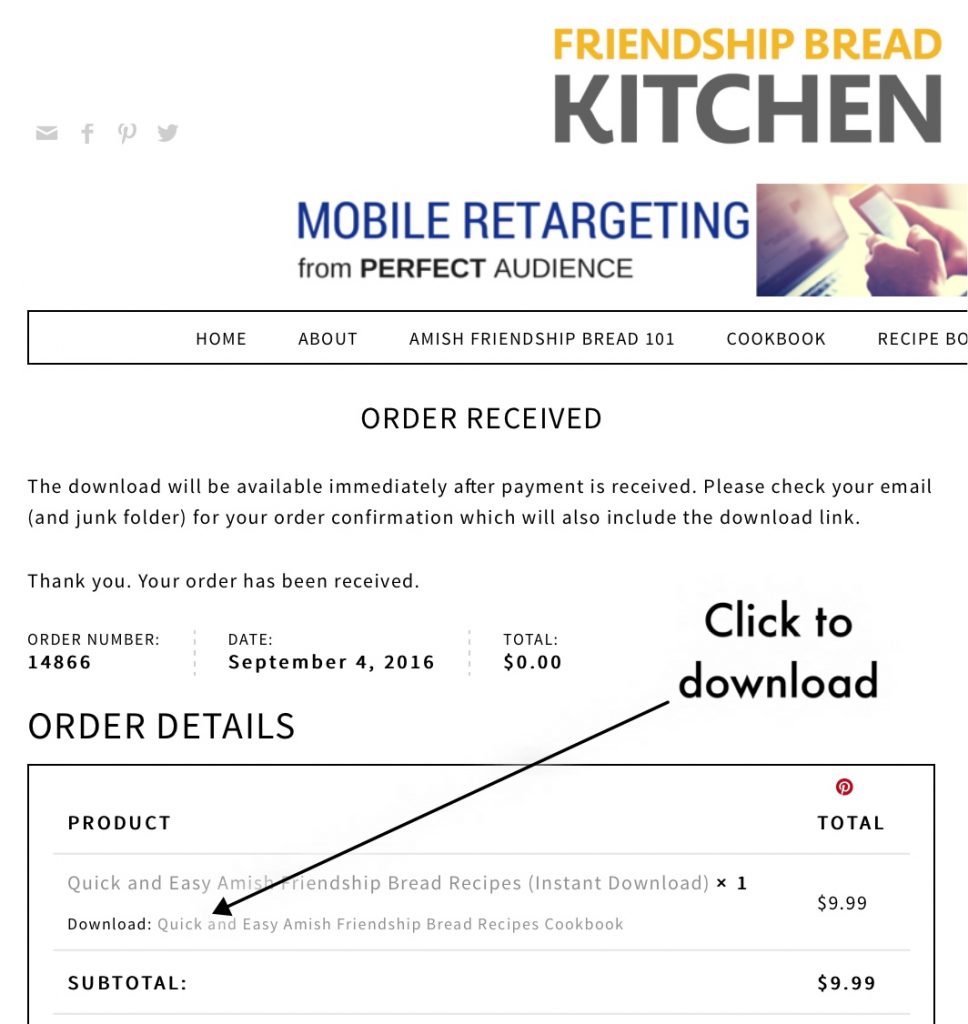
Q. I can’t find my downloads!
A. Everybody’s computer is different, but in general after you download the files, the files will go to your “Downloads” folder or your Desktop unless you designate a different folder. Another option is to do a search for the file name (hint: search for “Amish Friendship Bread” and see if it appears that way). If all else fails, please reply to the email you received that confirmed your purchase (not your PayPal receipt). Be sure to whitelist order@friendshipbreadkitchen.com in your email as well — sometimes your PayPal email may go directly into your inbox, but the confirmation with the download links may end up in your junk or spam folder.
These links might help:
- Where do downloads go on Android: https://www.businessinsider.com/where-do-downloads-go-on-android
- Where do downloads go on iPhone or iPad: https://www.howtogeek.com/688893/how-to-find-downloaded-files-on-an-iphone-or-ipad/
- Where do downloads go on a Mac: https://www.businessinsider.com/how-to-find-downloads-on-mac
- Where do downloads go on a PC (Windows 10): https://support.microsoft.com/en-us/windows/find-my-downloads-in-windows-10-de903ee9-7d37-256b-9145-f0f016c5aed8
